Research on Wellbore Integrity Assurance Technology for Deepwater High-Pressure Oil and Gas Wells
Abstract
:1. Introduction
2. Basic Methods for Annular Pressure Analysis in Deepwater Oil and Gas Wells
2.1. Basic Equation of Wellbore Temperature Field
2.1.1. Heat Conduction
2.1.2. Heat Convection
2.2. Fundamental Equation of Annular Pressure
3. Establishment of Annular Pressure Analysis Model for Deepwater High-Pressure Oil and Gas Wells
3.1. Classical Analysis Model of Annular Pressure
3.2. Prediction Modeling of Annular Pressure Considering Formation-Cement Ring Permeability
4. Research on Annular Pressure Control in Deepwater High-Pressure Oil and Gas Wells
4.1. Annular Pressure and Temperature Control Method
4.1.1. Insulation Pipe
4.1.2. Annular Heat Insulation Fluid
4.2. Annular Pressure Control Methods
4.2.1. Pressure Relief Valve Technology
4.2.2. Annular Compressible Volume Technology
4.2.3. Pressure Relief Technology of Annular Pressure Formation
4.3. Recommended Methods for Annular Pressure Management in Deepwater High-Pressure Oil and Gas Wells
5. Engineering Case Analysis
5.1. Basic Information of Deepwater High-Pressure Oil and Gas Wells
5.2. Fundamental Analysis of Annular Pressure
5.3. Influence Analysis of PVT Characteristics of Annular Isolation Fluid
5.4. Analysis of Annular Pressure and Control Method
6. Conclusions and Suggestions
Author Contributions
Funding
Data Availability Statement
Conflicts of Interest
References
- Research Institute of Petroleum Exploration and Development. Global Oil and Gas Exploration and Oil Company Dynamics. Fault-Block Oil Gas Field 2017, 24, 792. [Google Scholar]
- Zhang, G.C.; Qu, H.J.; Zhao, C.; Zhang, F.L.; Zhao, Z. Giant discoveries of oil and gas exploration. Nat. Gas Geosci. 2017, 28, 1447–1477. [Google Scholar]
- Yang, L.; Wang, L.; Pan, J. Situation and Prospect of global deepwater oil and gas exploration and development. China Min. Mag. 2017, 26, 14–17. [Google Scholar]
- Bradford, D.W.; Fritchie, D.G.; Gibson, D.H.; Gosch, S.W.; Pattillo, P.D.; Sharp, J.W.; Taylor, C.E. Marlin failure analysis and redesign:part 1-description of failure. SPE Drill. Complet. 2004, 19, 101–104. [Google Scholar] [CrossRef]
- Pattillo, P.D.; Cocales, B.W.; Morey, S.C. Analysis of an annular pressure buildup failure during drill ahead. SPE Drill. Complet. 2006, 21, 242–247. [Google Scholar] [CrossRef]
- Pattillo, P.D.; Sathuvalli, U.B.; Rahman, S.M.; Prewett, H.H.; Carmichael, S.P.; Wydrinski, R. Mad Dog Slot W1 Tubing Deformation Failure Analysis; SPE: Los Angeles, CA, USA, 2007; p. 109882. [Google Scholar]
- Ferreira, M.V.; Hafemann, T.E.; Barbosa, J.R.; da Silva, A.K.; Hasan, R. A Numerical Study on the Thermal Behavior of Wellbores. SPE Prod. Oper. 2017, 31, 564–574. [Google Scholar] [CrossRef]
- Yin, F.; Gao, D. Improved Calculation of Multiple Annuli Pressure Buildup in Subsea HPHT Wells; IADC/SPE: Bangkok, Thailand, 2014; p. 170553. [Google Scholar]
- Liu, B.; Yang, J.; Zhou, B.; Yan, D.; Tian, R.; Liu, Z.; Luo, J.; Huang, X. Study of Casing Annulus Pressure for Deepwater Drilling and Completions; SPE: Houston, TX, USA, 2014; p. 170318. [Google Scholar]
- Zhang, B.; Guan, Z.; Zhang, Q. Prediction and analysis on annular pressure of deepwater well in the production stage. Acta Pet. Sin. 2015, 36, 1012. [Google Scholar]
- Zhang, B.; Zhichuan, G.U.; Sheng, Y.; Qing, W.A.; Chuanbin, X.U. Impact of wellbore fluid properties on trapped annular pressure in deepwater wells. Pet. Explor. Dev. 2016, 43, 869–875. [Google Scholar] [CrossRef]
- Hasan, A.R.; Kabir, C.S.; Wang, X. Wellbore Two-Phase Flow and Heat Transfer During Transient Testing. SPE J. 1998, 3, 174–180. [Google Scholar] [CrossRef]
- Hu, Z. Research on the Risk Assessment and Prevenrion Methods of Annular Pressure Buildup in Deepwater Wells; China University of Petroleum: Beijing, China, 2019. [Google Scholar]
- Liu, J. Research on the Annular Pressure Buildup and Mitigation Mechanism in Deepwater Wells; China University of Petroleum: Beijing, China, 2017. [Google Scholar]
- Zhang, B. Prediction and Mitigation Mechanism of Casing Annular Pressure in Deepwater Wells; China University of Petroleum: Beijing, China, 2018. [Google Scholar]
- Williamson, R.; Sanders, W.; Jakabosky, T.; Serio, M.; Griffith, J.E. Control of Contained-Annulus Fluid Pressure Buildup; SPE: Amsterdam, The Netherlands, 2003; p. 79875. [Google Scholar]
- Gosch, S.W.; Horne, D.J.; Pattillo, P.D.; Sharp, J.W.; Shah, P.C. Marlin failure analysis and redesign: Part 3-VIT completion with real-time monitoring. SPE Drill. Complet. 2004, 19, 120–128. [Google Scholar] [CrossRef]
- Azzola, J.H.; Tselepidakis, D.P.; Pattillo, P.D.; Richey, J.F.; Tinker, S.J.; Miller, R.A.; Segreto, S.J. Application of Vacuum Insulated Tubing to Mitigate Annular Pressure Buildup. SPE Drill. Complet. 2007, 22, 46–51. [Google Scholar] [CrossRef]
- Ezzat, A.M.; Miller, J.J.; Ezell, R.; Perez, G.P. High-Performance Water-Based Insulating Packer Fluids; SPE: Los Angeles, CA, USA, 2007; p. 109130. [Google Scholar]
- Horton, R.L.; Froitland, T.S.; Foxenberg, W.E.; Knox, D. A New Yield Power Law Analysis Tool Improves Insulating Annular Fluid Design; IPTC: Doha, Qatar, 2005; p. 10006. [Google Scholar]
- Eriksen, K.; Panamarathupalayam, B.; Foxenberg, W.E.; Chumakov, E. A Novel High Temperature Insulating Packer Fluid (Russian); SPE: Moscow, Russia, 2014; p. 171284. [Google Scholar]
- Javora, P.H.; Pearcy, R.; Wang, X.; Stevens, D.; Qu, Q. A Decade of Experience: The Water Based Thermal Insulating Packer Fluid; SPE: Denver, CO, USA, 2008; p. 116769. [Google Scholar]
- Sathuvalli, U.B.; Pilko, R.M.; Gonzalez, R.A.; Pai, R.M.; Sachdeva, P.; Suryanarayana, P.V. Design and Performance of Annular-Pressure-Buildup Mitigation Techniques. SPE Drill Compl. 2017, 32, 168–183. [Google Scholar] [CrossRef]
- Wu, Y. Study on the Simplification Technology of Surface Casing in Deepwater Drilling. China Pet. Mach. 2017, 45, 53–56. [Google Scholar]
- Bo, Z.H.; Jin, Y.; Zhengli, L.I.; Junfeng, L.U.; Huang, X.; Rongxin, Z.H.; Yu, S.O. Mechanism of pressure management by injecting nitrogen in casing annulus of deepwater wells. Pet. Explor. Dev. 2015, 42, 422–426. [Google Scholar]
- Bailing, Z.H.; Jin, Y.A.; Xiaolong, H.U.; Zhiqiang, H.U.; Li, H.E. Adaptability evaluation of calculation model of annular pressure of deepwater wellbore. Oil Drill. Prod. Technol. 2015, 37, 56–59. [Google Scholar]
- Wu, Y.; Yang, C.; Liu, S.; Fan, B.; Cheng, Z.; Du, J. Development of multi-body dynamic solver for offshore drilling risers. Shipbuild. China 2019, 60, 83–90. [Google Scholar]
- Kan, C.; Yang, J.; Yu, X. Heat-insulated testing string technology for deepwater HTHP wells. Oil Drill. Prod. Technol. 2016, 38, 796–800. [Google Scholar]
- Huang, X.; Yan, D.; Tian, R.; Liu, Z.; Ye, J.; Fang, M.; Zhang, X. Analysis of trap pressure calculation and control technology in deep casing annulus. China Offshore Oil Gas 2014, 26, 61–65. [Google Scholar]
- Zhao, W.; Leng, X.; Chen, B.; Mu, X.; Ener Tech-Drilling & Production Co., CNOOC; Shenzhen Branch, CNOOC. Discussion the Method of Monitoring and Diagnostic Method for Annular Pressure Buildup in Deepwater Well. Oil Field Equip. 2016, 45, 5–10. [Google Scholar]
- Ilyushin, Y.V.; Fetisov, V. Experience of virtual commissioning of a process control system for the production of high-paraffin oil. Sci. Rep. 2022, 12, 18415. [Google Scholar] [CrossRef] [PubMed]
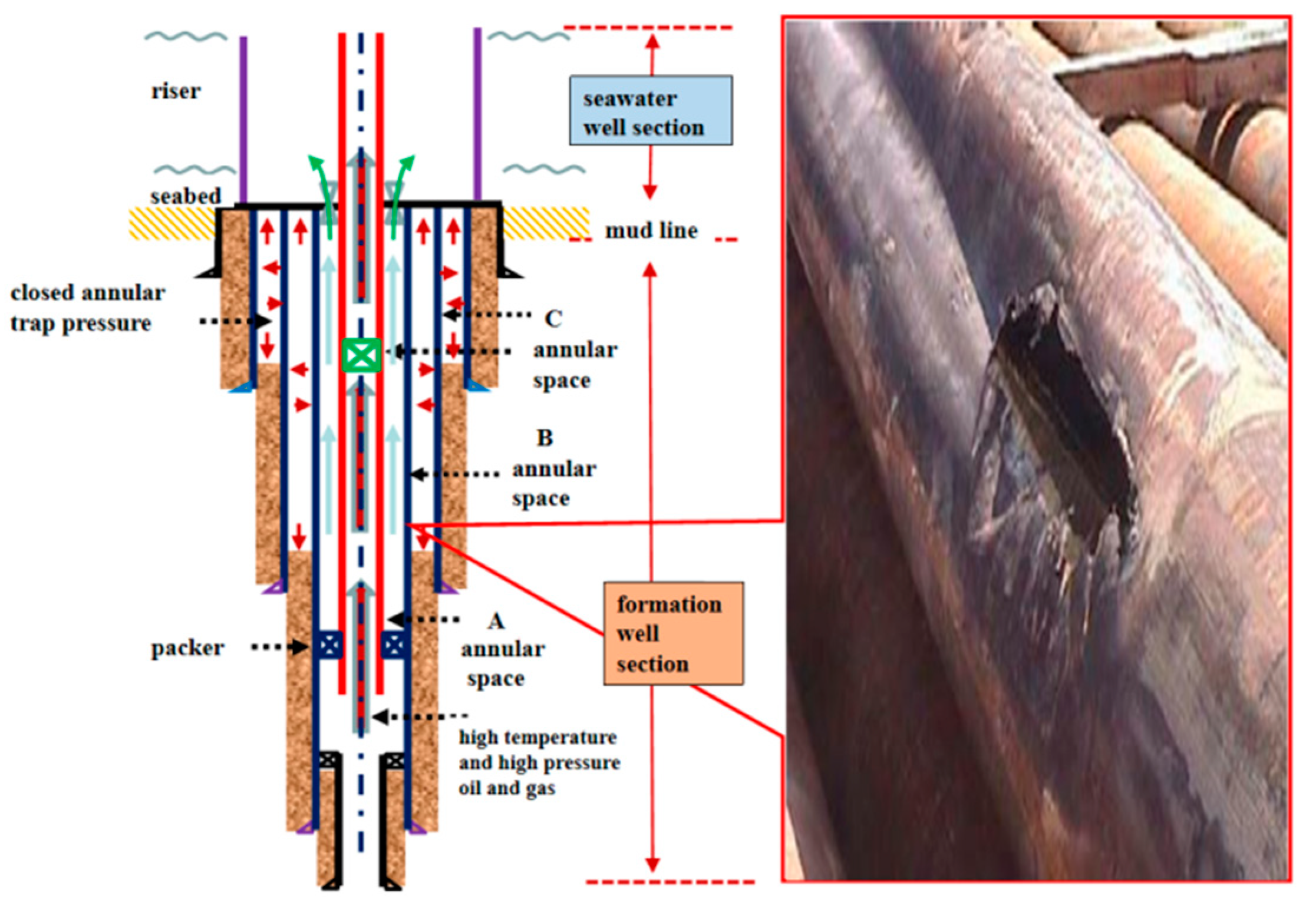

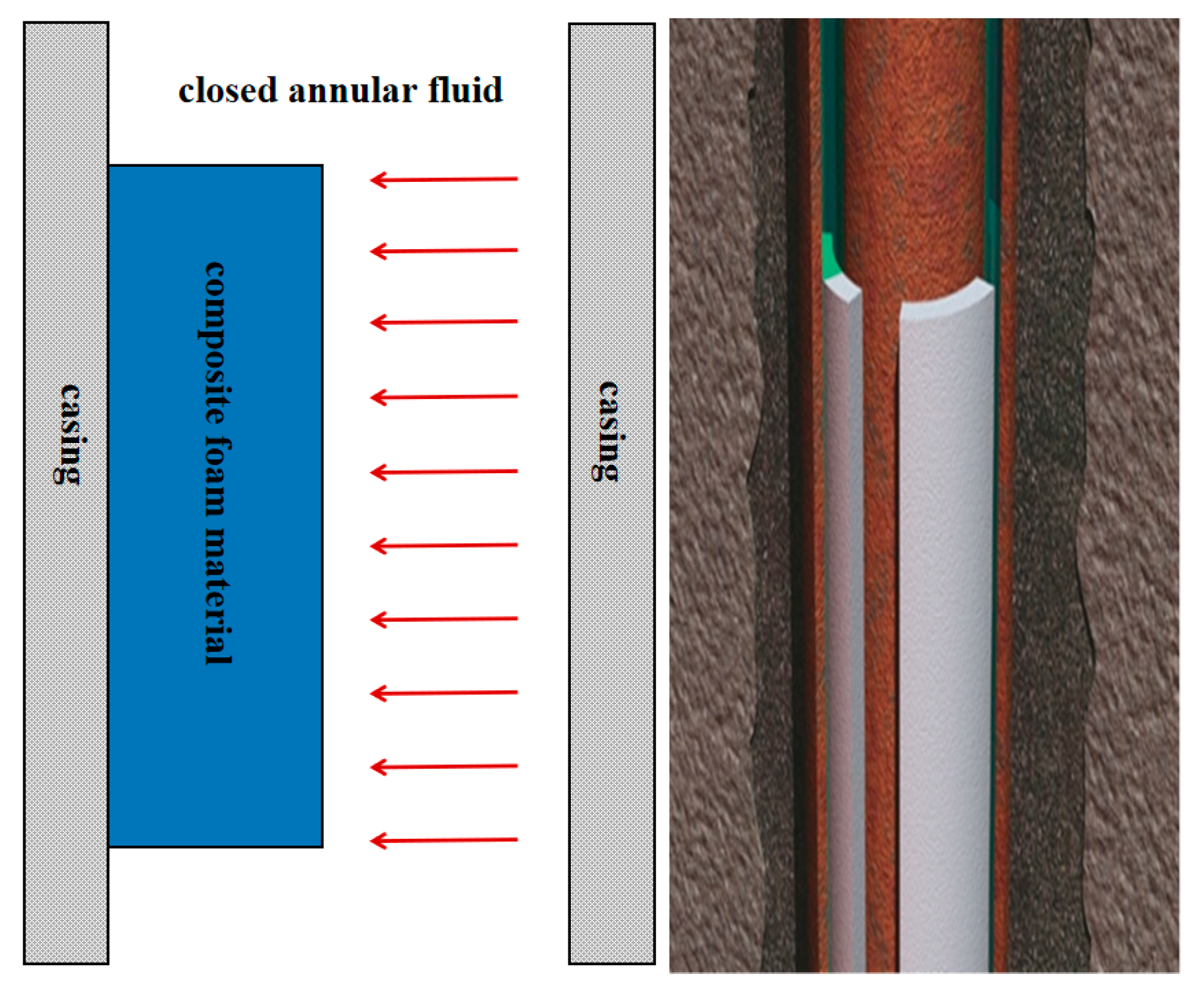
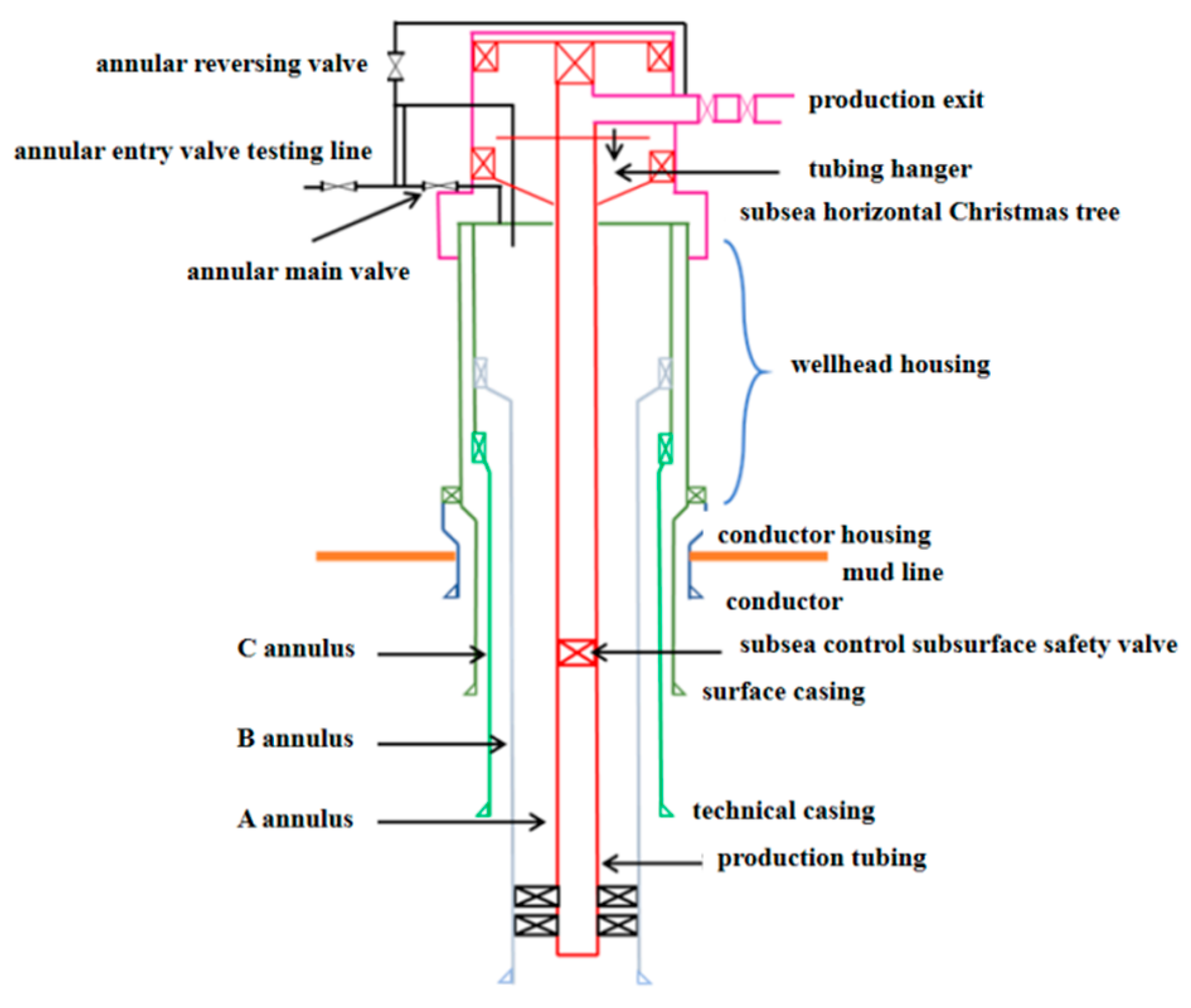

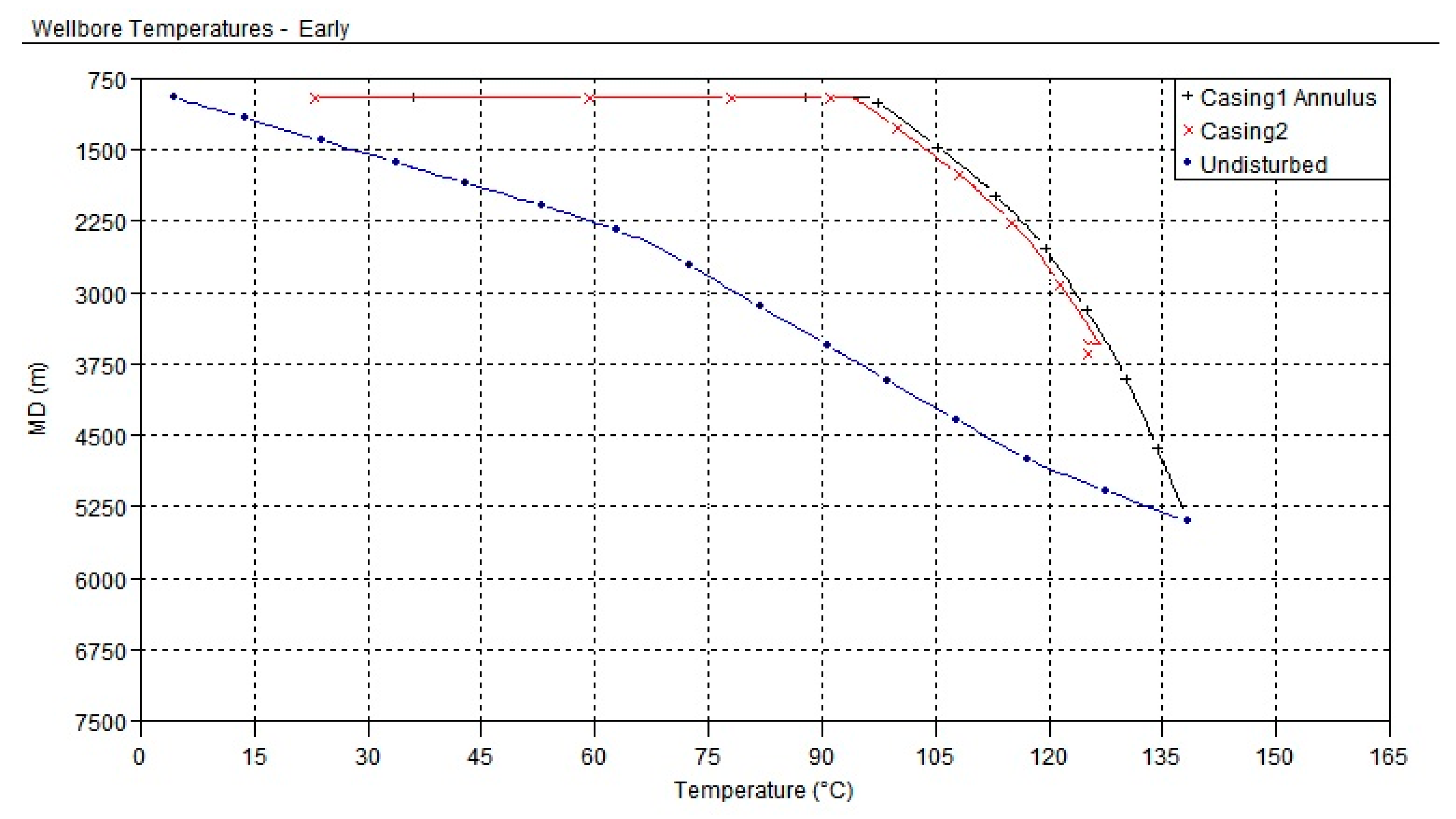
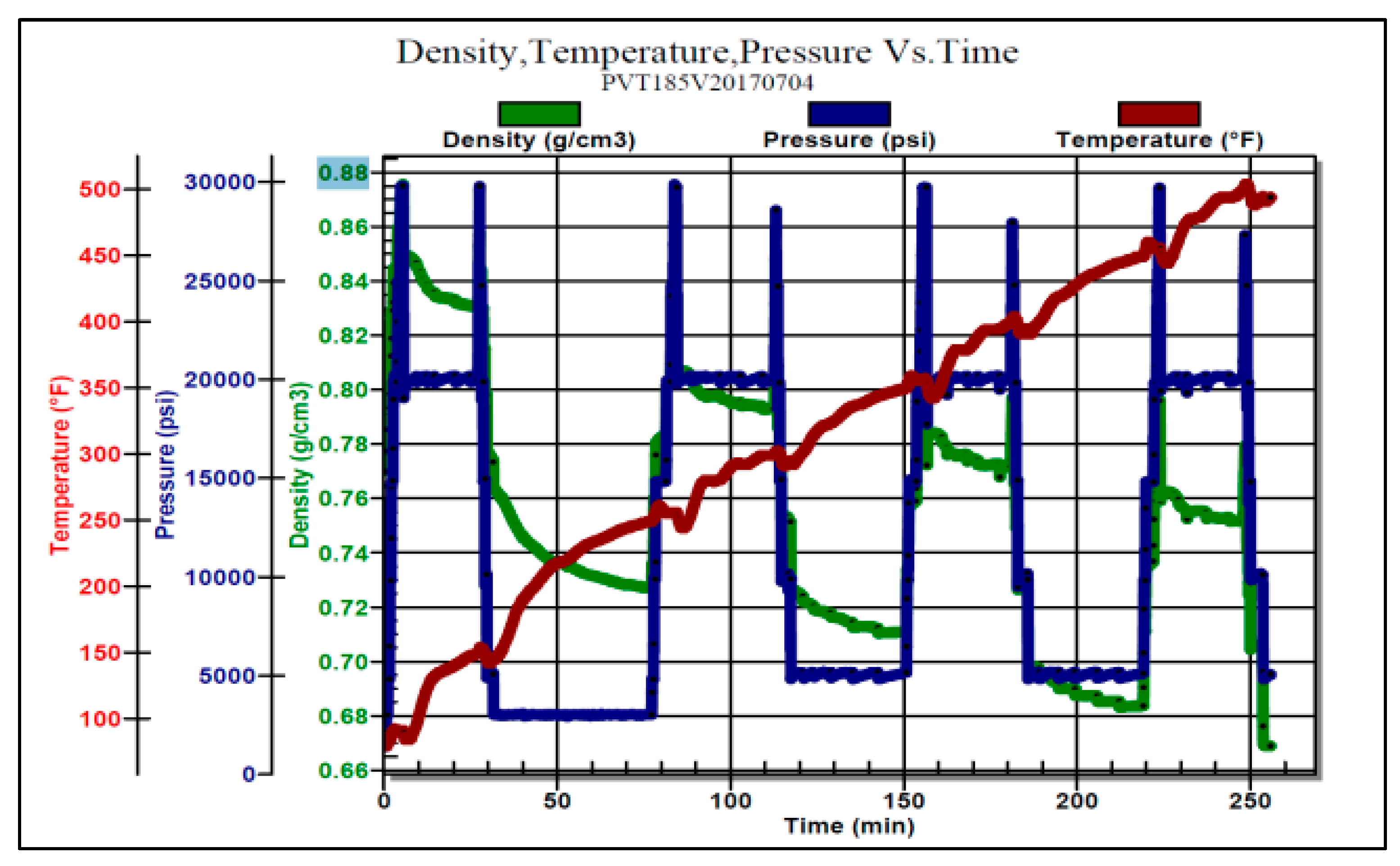
| Control Measures | Technical Advantages | Technical Disadvantages | Scope of Application | Reliability | Cost of Operations | |
|---|---|---|---|---|---|---|
| Annular temperature control | Insulation pipe | High requirements for on-site operation | High thermal conductivity at the junction | Wide | Medium | High |
| Annulus insulation fluid | Convenient on-site operation | Limited isolation range | Wide | Medium | Medium | |
| Annular pressure control | Install pressure relief valve | Easy installation | Damage to well integrity; High requirement for formation pressure prediction; The risk of solid phase precipitation being buried; Limited pressure test and well control | Wide | Medium | Low |
| Hollow microsphere isolation fluid | Convenient on-site operation | Prevent glass microspheres from breaking early under the pressure of liquid column | Wide | Poor | Medium | |
| Compressible foam | Ensure well integrity, wide range of pressure control options, and high requirements for on-site construction sites | Unable to recover, easy to cause vacuum | Wide | High | High | |
| Inject compressible inert gas | Ensure well integrity, wide range of pressure control options, and high requirements for on-site construction sites | Nitrogen leaks easily; Too much pressure turns into liquid nitrogen | Low | High | High | |
| Pressure relief technology of annular pressure formation | Annular pressure problem partially solved; cementing relatively easy | Need to measure cement return; The solid phase content of drilling fluid easily causes trap space | High | High | Low | |
| A annular pressure relief/replenishment technology | Easy to operate | The pressure of B and C annulus is unknown and the control range is limited | Medium | Medium | Low | |
| Elimination of annulus | Complete sealing and cementing | Roots on solve the problem of annulus with pressure, without management | Deepwater cementing is difficult or impossible; Easy to cause the sealing assembly and BOP cement contact brings complex situation | Low | Low | Medium |
| Name | Outside Diameter m | Wire Weight kg/m | Steel Grade | Depth m |
|---|---|---|---|---|
| Conductor | 914 | 351.3 | X56 | 1072.7 |
| Surface casing | 508 | 197.9 | X56 | 1700 |
| Technical casing | 339 | 101.2 | P110 | 3385 |
| Production casing | 245 | 79.6 | P110 | 5170 |
| Liner | 178 | 47.6 | P110 | 4600–5375 |
| Tubing | 114 | 22.6 | P110 | 5300 |
| String | Annulus | Expansion Coefficient/Compression Coefficient is Constant | Expansion Coefficient/Compression Coefficient Varies with PVT | |||
|---|---|---|---|---|---|---|
| Top Depth | Bottom Depth | Trap | Fluid | Trap | Fluid | |
| m | m | Pressure | Volume | Pressure | Volume | |
| MPa | m3 | MPa | m3 | |||
| 339 mm casing (C annulus) | 957.7 | 1966 | 9.51 | 4.53 | 9.51 | 4.51 |
| 245 mm casing (B annulus) | 957.7 | 4400 | 57.87 | 4.29 | 37.58 | 4.3 |
| 114 mm tubing (A annulus) | 957.7 | 4920 | 70.32 | 2.01 | 66.08 | 1.99 |
| Working Condition | String | Annulus | Initial Production | Medium Production | Late Production | ||||
|---|---|---|---|---|---|---|---|---|---|
| Top Depth m | Bottom Depth m | Trap Pressure MPa | fluid Volume m3 | Trap Pressure MPa | fluid Volume m3 | Trap Pressure MPa | Fluid Volume m3 | ||
| A annular pressure not managed | 339 mm Casing C annulus | 957.7 | 1966 | 9.51 | 4.51 | 9.51 | 2.83 | 9.51 | 2.12 |
| 245 mm casing B annulus | 957.7 | 4400 | 37.58 | 4.3 | 25.66 | 2.8 | 21.1 | 2.26 | |
| 114 mm tubing A annulus | 957.7 | 4920 | 66.08 | 1.99 | 46.08 | 1.35 | 38.41 | 1.12 | |
| A annular pressure management (APB = 15 MPa) | 339 mm Casing C annulus | 957.7 | 1966 | 9.51 | 4.51 | 9.51 | 2.83 | 9.51 | 2.12 |
| 245 mm casing B annulus | 957.7 | 4400 | 33.34 | 4.3 | 23.07 | 2.8 | 19.13 | 2.26 | |
| 114 mm tubing A annulus | 957.7 | 4920 | 15 | 1.99 | 15 | 1.35 | 15 | 1.12 | |
| A annular pressure management (APB = 25 MPa) | 339 mm Casing C annulus | 957.7 | 1966 | 9.51 | 4.51 | 9.51 | 2.83 | 9.51 | 2.12 |
| 245 mm casing B annulus | 957.7 | 4400 | 34.16 | 4.3 | 23.9 | 2.8 | 19.97 | 2.25 | |
| 114 mm tubing A annulus | 957.7 | 4920 | 25 | 1.99 | 25 | 1.35 | 25 | 1.12 | |
Disclaimer/Publisher’s Note: The statements, opinions and data contained in all publications are solely those of the individual author(s) and contributor(s) and not of MDPI and/or the editor(s). MDPI and/or the editor(s) disclaim responsibility for any injury to people or property resulting from any ideas, methods, instructions or products referred to in the content. |
© 2023 by the authors. Licensee MDPI, Basel, Switzerland. This article is an open access article distributed under the terms and conditions of the Creative Commons Attribution (CC BY) license (https://creativecommons.org/licenses/by/4.0/).
Share and Cite
Wu, Y.; Zhou, J.; Yang, J.; Zhang, T.; Zou, X.; Zhang, X.; Xu, G. Research on Wellbore Integrity Assurance Technology for Deepwater High-Pressure Oil and Gas Wells. Energies 2023, 16, 2230. https://doi.org/10.3390/en16052230
Wu Y, Zhou J, Yang J, Zhang T, Zou X, Zhang X, Xu G. Research on Wellbore Integrity Assurance Technology for Deepwater High-Pressure Oil and Gas Wells. Energies. 2023; 16(5):2230. https://doi.org/10.3390/en16052230
Chicago/Turabian StyleWu, Yi, Jianliang Zhou, Jin Yang, Tianwei Zhang, Xin Zou, Xingquan Zhang, and Guoxian Xu. 2023. "Research on Wellbore Integrity Assurance Technology for Deepwater High-Pressure Oil and Gas Wells" Energies 16, no. 5: 2230. https://doi.org/10.3390/en16052230
APA StyleWu, Y., Zhou, J., Yang, J., Zhang, T., Zou, X., Zhang, X., & Xu, G. (2023). Research on Wellbore Integrity Assurance Technology for Deepwater High-Pressure Oil and Gas Wells. Energies, 16(5), 2230. https://doi.org/10.3390/en16052230






